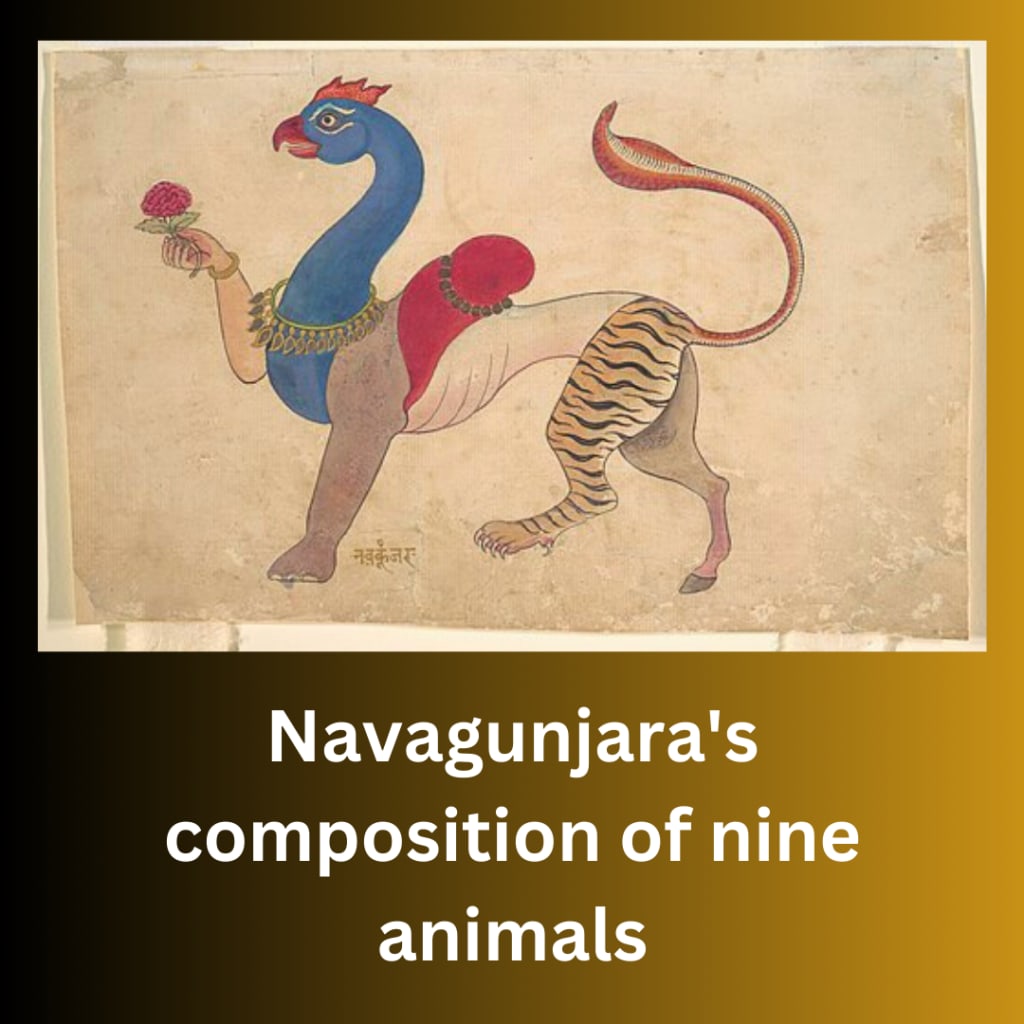Navagunjara: Unveiling the Divine Tapestry of Hindu Spirituality
Composition of Nine Animals

In Hinduism, Navagunjara holds profound spiritual significance. It is representing the complexity and diversity of the divine. Each animal component symbolizes different aspects of existence. Together they form a harmonious whole, reflecting the interconnectedness of all life.
Composition of Nine Animals: Navagunjara's composition of nine animals. It symbolizes the multiplicity of existence and the divine's ability to manifest in diverse forms. This reflects the Hindu belief in the multifaceted nature of God. The God can appear in various guises to fulfill different purposes and connect with devotees in different ways.
Astral Form of Vishnu or Krishna: Navagunjara is considered an astral form of Vishnu or Krishna. It is indicating its divine origin and association with the supreme deity. This celestial manifestation emphasizes the transcendental nature of the divine. Its ability to transcend earthly limitations.
Variant of Virat-Rupa: Navagunjara is regarded as a variant of the virat-rupa, the cosmic form of Krishna described in the Bhagavad Gita. This form represents the all-encompassing nature of the divine. It is encompassing the entire universe within itself. Through Navagunjara, devotees can contemplate the vastness and intricacy of creation.
Encounter with Arjuna: The narrative of Arjuna encountering Navagunjara highlights the theme of divine revelation and realization. Initially perplexed and fearful, Arjuna gradually recognizes the divine presence within Navagunjara. It is illustrating the journey from ignorance to enlightenment. His act of bowing before Navagunjara symbolizes surrender to the divine will and acceptance of its inscrutable ways.
Depiction in Art and Architecture: The representation of Navagunjara in art and architecture, such as Pata-Chitra paintings and sculptures on the Jagannath Temple. It serves as a visual reminder of the divine's omnipresence and multifaceted nature. These artistic expressions enable devotees to contemplate the spiritual significance of Navagunjara and deepen their understanding of the divine mystery.
In essence, Navagunjara embodies the spiritual themes of divine diversity, revelation, and surrender, inviting devotees to contemplate the profound mysteries of existence and their connection to the divine.
In Hindu spirituality, the nine organs of Navagunjara carry symbolic significance. It is representing different aspects of existence and the divine attributes they embody. Here's an interpretation of each organ from a spiritual perspective:
1. Head of a Rooster: The rooster's head symbolizes vigilance and awakening. It represents the importance of being alert and aware on the spiritual path, always ready to confront challenges and obstacles with courage and clarity.
2. Three Feet: The three feet of an elephant, tiger, and deer or horse signify strength, power, and agility, respectively. Together, they represent the balance of strength, courage, and grace needed to navigate life's journey with resilience and determination.
3. Fourth Limb: The raised human arm carrying a lotus or a wheel represents divine grace and guidance. The lotus symbolizes purity and spiritual enlightenment, while the wheel represents the cyclical nature of existence and the law of karma. This limb signifies the divine's benevolent presence and its role in guiding and supporting devotees on their spiritual evolution.
4. Neck of a Peacock: The peacock's neck symbolizes beauty and divine splendor. It represents the aesthetic aspect of spirituality, reminding us to appreciate the beauty and wonder of creation as manifestations of the divine.
5. Back or Hump of a Bull: The bull's back or hump symbolizes strength, stability, and fertility. It represents the foundational support of the divine in sustaining the universe and upholding the cosmic order.
6. Waist of a Lion: The lion's waist symbolizes courage, majesty, and nobility. It represents the inner strength and fortitude needed to confront and overcome challenges on the spiritual path. It is empowering devotees to embody courage and resilience in the face of adversity.
7. Tail of a Serpent: The serpent's tail symbolizes regeneration and transformation. It represents the cyclical nature of life, death, and rebirth. Also as well as the shedding of ego and attachments to attain spiritual renewal and growth.
Each organ of Navagunjara offers a profound spiritual lesson. It is guiding devotees on their journey of self-discovery and enlightenment. Together, they form a holistic representation of the divine, encompassing the diverse qualities and attributes necessary for spiritual evolution and realization.





Comments
There are no comments for this story
Be the first to respond and start the conversation.